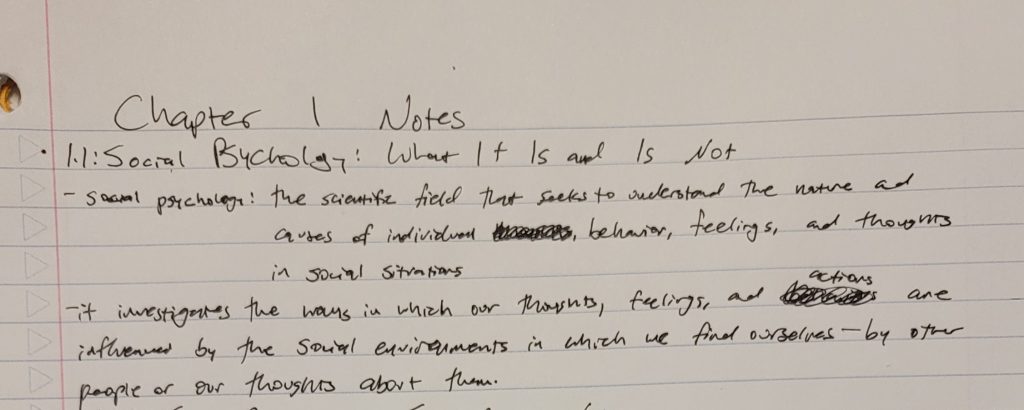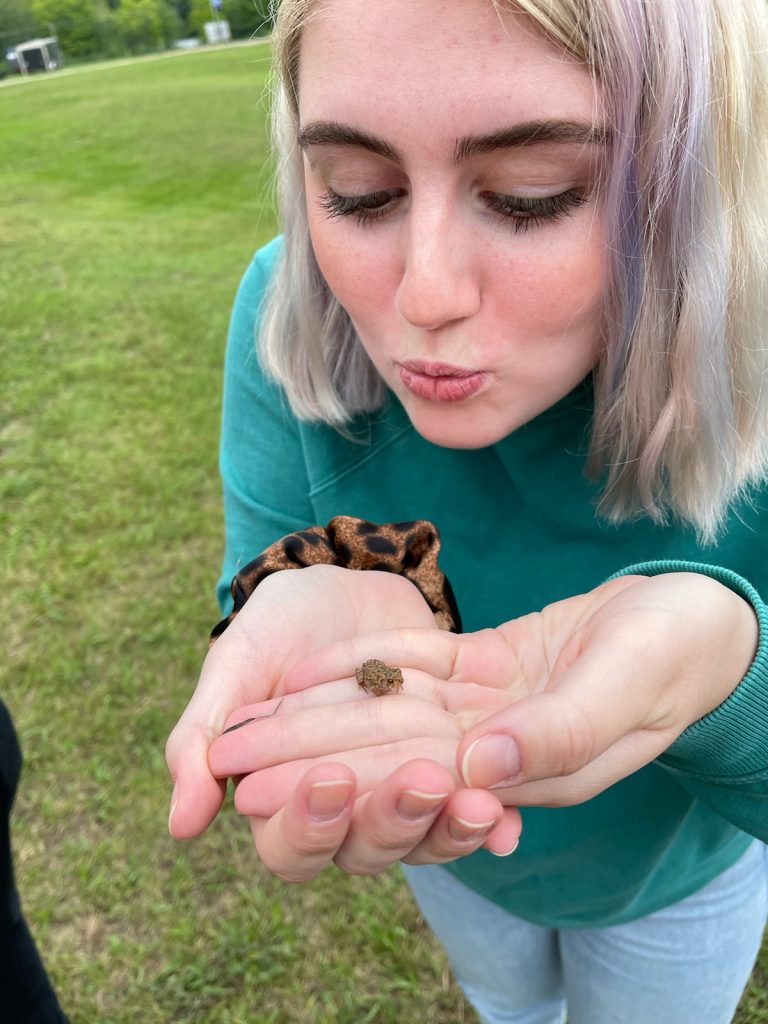Week 1

As a future high school math teacher, social psychology is very relevant to my career. I will always be in a setting where my students and I are interacting with each other within different social settings from our classroom and to a greater extent, the school, and even greater the world in general. There will be a lot of things that I learn in this course that will help me understand what they are going through and how I contribute to their social environment. The second objective in the course syllabus states that we will “discuss the processes through which people perceive and attempt to understand others”. High school is a notoriously scary and difficult time for students socially, so by understanding how they’re perceiving each other, I can help them navigate that era of their lives. Additionally, in this course we will “discuss the origins and effects of prejudice and discrimination.” High school is a time where students begin to understand the world around them and see how their actions affect those they meet. One thing that the students will learn about is prejudice and discrimination. While I, as a math teacher, won’t have any ways this is relevant to the subject material, I still see myself as responsible for how they grow and who they become in the future, so understanding prejudice and discrimination to a higher degree will help me explain it to my students and help them see how their actions are right or wrong.
From this course, I expect to gain a deeper level of understanding of the world around me. Social psychology is a very interesting field and I hope to gain a lot of knowledge about my role in society and how my actions affect the whole. In order to gain this knowledge, I need to stay on top of deadlines, read the material, and think about how it all fits together and how I can apply it to my life.
Week 2

To describe myself as a student I could steal a Spider-Man 2 quote: “brilliant, but lazy”, although brilliant could be a stretch. What I mean is I’m great at math (my major) and when I apply myself, I can solve most of the problems thrown my way and enjoy myself at the same time. The problem is, I have a hard time with my motivation. I find myself putting work off until I make deadlines by a slim margin or not at all. The GSE asked a lot about my ability to come up with solutions and my ability to think on my feet. These are things that I believe I’m good at, but could improve upon. I don’t feel that it’s an accurate measure of someone’s general aptitude as a student because I (and I assume many other students) have issues with motivation and timeliness, which the GSE does not ask about. I got a mean score of 2.9 on the GSE, putting me square on the average.
Week 3

My girlfriend, Colleen 
My parents 
My roommate, Gage
I remember when I first started dating my girlfriend, one of the first things we talked about was music taste. That’s how it goes a lot of the time when people are trying to get to know each other. It’s not surprising that sharing music taste is a good way to get to know a person on a deeper level. My girlfriend and I don’t have the same music taste (although we have songs we both like and we don’t dislike the other’s taste), and my roommate and I have similar music tastes, but not identical. These two people are the ones I’m closest to and who I share similar values with the most. The six songs I chose that I associate the most with key people/memories are as follows:
- Nirvana’s Drain You – myself
- Nirvana is my favorite band and Drain You is my favorite song by them. It also coincidentally is the first song of theirs I heard before I was even aware of who/what Nirvana was.
- Taylor Swift’s invisible string – my girlfriend
- If my girlfriend and I had “our” song, it would be this. We talk a lot about how much the song’s lyrics and meaning apply to the both of us.
- Pearl Jam’s Black – my mom
- While the lyrics themselves don’t remind me of my mom, the song itself does. I remember this being one of the first songs that I found out my mom liked that made me think, “Woah. My mom likes cool music too?”
- Rodney Atkins’ Watching You – my dad
- Growing up, my parents listened to a lot of country music and I remember this song specifically coming on and noticing that Atkins sings about how much his son looked up to him and thinking to myself that I look up to my dad just as much as the kid in the song does.
- Foo Fighters’ Everlong – my roommate
- This song is one of my all time favorite songs. When my roommate and I were freshmen, we lived in a dorm together. One night early on in the semester, we walked about two miles to a video game store in Ghent. We didn’t know each other very well so of course we were sharing music taste. I believe he didn’t know about Foo Fighters’ music very much, but he knew this song so on the way back, we listened to it and sang along.
- Alan Silvestri’s Portals from Avengers: Endgame – my first time watching that movie
- In the movie, this song plays when just about everyone from ten years of Marvel movies shows up all at once. As a huge fan of comic books and comic book movies, it was very very exciting to see for the first time.
Week 4

The process of reviewing what I got wrong on Test 1 gave me an idea of what types of questions I tend to miss and what I should do to adjust my study habits to perform better. I found that a lot of the correct answers were only slightly different from my incorrect answers. An example of this would be the difference between informed consent and briefing. They’re very similar concepts, but it comes down to fine details. In the future, and while studying for the final, I will make note of vocabulary that is closely related to each other, but different by slight details.
Week 5
Here is an ad for ODU’s graduate school. As a senior about to get my Bachelor’s, I am the intended audience for ads like these. They use the Dean of the Graduate School to influence students to apply, and use enticing language to make it more appealing. Hearing about this from a member of the faculty, while biased, is still more reliable than someone from outside the school being paid to speak kindly about the school.
This was a Super Bowl ad for a cryptocurrency trading site. I generally distrust cryptocurrency, but personal biases aside, these celebrities are unreliable sources. Both of the celebrities, Tom Brady and Gisele Bündchen, have an equity stake in the company (meaning they own a portion of the company). This makes them unreliable advertisers because they have a personal and financial stake in the company.

This is an ad from 2002 for a GameCube wireless controller called the Wavebird. At the time, wireless gaming was a new concept and being able to play on a controller connected to a console without a wire was incredible. Here, they used the image of a woman in a bath to sell the idea that you can play from anywhere. While an absurd situation, using a woman bathing in the ad was very obviously a deliberate choice. As the saying goes, sex sells. The gaming community at the time was largely male dominated, so this ad likely drew in many men with the image, and kept them with the innovative addition to the gaming industry. Physical attractiveness of an advertiser is often effective. Usually this is done with a physically attractive celebrity spokesperson.
Week 6
Week 7
Week 8

In the article, DeWall heavily emphasizes the genetic differences in men and women that can cause those arguments that are so common. While reading the article, I recognized the examples, but had never considered that it comes down to a genetic difference. While I wasn’t surprised, I had also not considered just how different the issues in heterosexual relationships would be from same-sex relationships. Another thing that struck me as surprising is the paragraph or two where DeWall almost seems to justify teaching evolutionary psychology being a field and being taught in a classroom. It always surprises me when I’m reminded that there are people that still don’t believe in evolution and beyond that, don’t believe it has any place in a classroom, whether that be a biology classroom or a psychology classroom. Lastly, as a future educator, I appreciated DeWall’s want for an activity that incited a lively discussion that would kickstart a deep dive into a new subject. That is something that takes students by surprise when they’re a part of it, but having a seemingly disconnected and fun discussion that in actuality has a lot to do with the lesson is incredibly important for engaging students and getting them excited to learn some new material. It’s something that I’m constantly seeking for math lessons since they’re so generally loathed.
As for my responses to the questions given by the slides, I think the article hit the nail on the head when considering the common reasons the different sexes get frustrated in a relationship. Lying in order to gain or avoid sexual activity, and jealousy are key aspects that can cause tension and arguments. One that DeWall hinted towards, but did not outright mention is infidelity. Anecdotal evidence points toward men cheating more than women which would obviously cause tension in a relationship, and be a way that a man would anger a woman. A way that a woman could anger a man is with a lack of communication. Again, using anecdotal evidence, it’s common for women to say they’re “fine” when something is bothering them, instead of airing their frustrations.
Week 10

I believe that, for the most part, I have achieved the course expectations. I’ve been able to perform well on tests and in lectures I understand the material given to us. My attitudes about Social Psychology have not changed. I always believed in its merit and that it’s applicable in many cases and helps those understand the world around them. An example of that comes from the flowchart above from the Chapter 11 PowerPoint. It explains how groups may splinter. Without getting into TMI territory, a group of my friends and I recently had a falling out, and it followed that process almost exactly. Without this course, I wouldn’t have been able to recognize the fact that theres a process that occurs in situations like mine. If I were to take this course again, I would be more strict with myself about due dates and staying on top of the work. I haven’t grown much academically in this course, but with this course I’m taking some fairly difficult math classes (as that’s my major) and they’ve pushed me to take careful notes and work harder at recognizing patterns in problems and applying theory to practical problems. All of these skills in a way can translate to all courses, including this one.